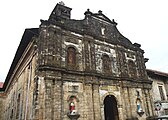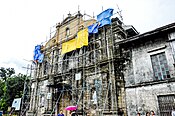Vicariate of
St. Andrew | - St. Jerome (Dueñas, Iloilo)
- St. William (Passi, Iloilo)
- St. Joseph (San Enrique, Iloilo)
- Mary, Help of Christians (San Enrique, Iloilo)
- Our Lady of Perpetual Help (Passi, Iloilo)
|
|---|
Vicariate of
St. Barnabas | - St. Teresa of Avila (Carles, Iloilo)
- St. Anne (Balasan)
- St. Vincent Ferrer (Batad, Iloilo)
- Queen of the Most Holy Rosary (Estancia, Iloilo)
|
|---|
Vicariate of St.
Bartholomew | - St. John the Baptist (Jordan, Guimaras)
- St. Michael the Archangel (Jordan, Guimaras)
- St. Vincent Ferrer (Nueva Valencia)
- Our Lady of Lourdes (Sibunag)
- Most Holy Name of Jesus (Buenavista, Guimaras)
- St. Isidore the Worker (Buenavista, Guimaras)
- St. Joseph (San Lorenzo, Guimaras)
- Personal Prelature of the Holy Cross (Iloilo City)
|
|---|
Vicariate of
St. James
the Greater | - St. John the Baptist (Sara, Iloilo)
- San Nicholas De Tolentino (Ajuy, Iloilo)
- Our Lady of Fatima (Ajuy, Iloilo)
- The Holy Child (Lemery, Iloilo)
- St. Vincent Ferrer (San Dionisio, Iloilo)
- Immaculate Conception (Concepcion, Iloilo)
|
|---|
Vicariate of
St. John | |
|---|
Vicariate of
St. Jude
Thaddeus | |
|---|
Vicariate of
St. Matthew | - St. Nicholas of Tolentine (Lambunao)
- St. Isidore the Farmer (Lambunao)
- Patronage of St. Joseph (Lambunao)
- The Immaculate Conception (Calinog)
- Sto. Nino (Calinog)
- Conversion of St. Paul (Bingawan)
|
|---|
Vicariate of
St. Matthias | - Patronage of St. Joseph (Pototan)
- Our Lady of Guadalupe (Pototan)
- Sto. Rosario (Pototan)
- The Holy Child (Pototan)
- Our Lady of Lourdes (Pototan)
- Our Lady of the Pillar (Mina, Iloilo)
- St. John the Baptist (Dingle, Iloilo)
- St. Isidore (Zarraga)
|
|---|
Vicariate of
St. Paul | - Santa Ana (Iloilo City)
- The Holy Name of Jesus (Iloilo City)
- San Jose Obrero (Iloilo City)
- Our Lady of the Assumption (Iloilo City)
- Our Lady of Fatima (Iloilo City)
- Sta. Teresita Del Nino Jesus (Iloilo City)
- Immaculate Conception (Iloilo City)
- Our Lady of the Miraculous Medal (Iloilo City)
- San Jose Placer (Iloilo City)
- Sta. Maria Chinese-Filipino (Iloilo City)
|
|---|
Vicariate of
St. Peter | |
|---|
Vicariate of
Sts. Philip
and James | |
|---|
Vicariate of
St. Simon
the Zealot | - St. Julian of Cuenca (Janiuay)
- St. John the Baptist (Badiangan)
|
|---|
Vicariate of
St. Thomas | - Sta. Barbara (Sta. Barbara, Iloilo)
- Our Lady of Fatima (Sta. Barbara, Iloilo)
- San Nicolas de Tolentino (Cabatuan, Iloilo)
- Our Lady of Candles (Cabatuan, Iloilo)
- St. James the Greater (Maasin, Iloilo)
- St. Martin de Porres (Maasin, Iloilo)
- Our Lady of Peace and Good Voyage (New Lucena)
|
|---|
Vicariate of
Sts. Titus
and Timothy | - St. Michael the Archangel (San Miguel, Iloilo)
- St. Thomas of Villanueva (Alimodian)
- St. Catherine of Alexandria (Leon, Iloilo)
- The Holy Child (Leon, Iloilo)
|
|---|







